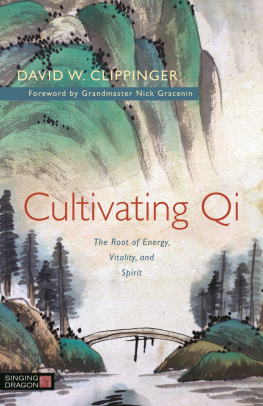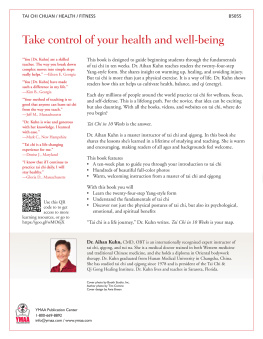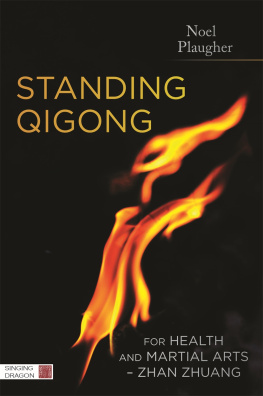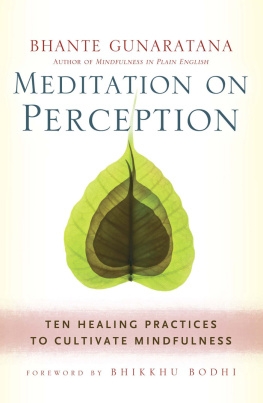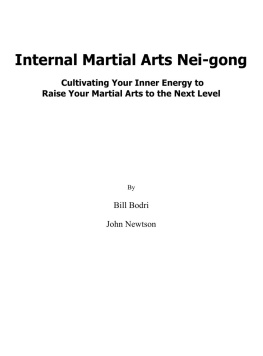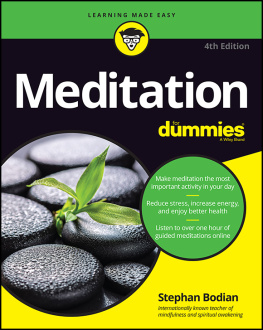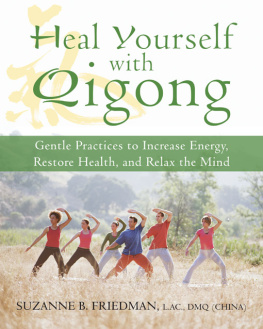
of related interest
Vital Breath of the Dao
Chinese Shamanic Tiger QigongLaohu Gong
Master Zhongxian Wu
ISBN 978 1 84819 000 9
eISBN 978 0 85701 110 7
Daoist Nei Gong
The Philosophical Art of Change
Damo Mitchell
Foreword by Cindy Engel
ISBN 978 1 84819 065 8
eISBN 978 0 85701 033 9
Qigong Through the Seasons
How to Stay Healthy All Year with Qigong, Meditation, Diet, and Herbs
Ronald H. Davis
Illustrated by Pamm Davis
Foreword by Ken Cohen
ISBN 978 1 84819 238 6
eISBN 978 0 85701 185 5
The Way of the Five Seasons
Living with the Five Elements for Physical, Emotional, and Spiritual Harmony
John Kirkwood
ISBN 978 1 84819 301 7
eISBN 978 0 85701 252 4
Cultivating
Qi
The Root of Energy, Vitality, and Spirit
David W. Clippinger
Foreword by Grandmaster Nick Gracenin

LONDON AND PHILADELPHIA
First published in 2016
by Singing Dragon
an imprint of Jessica Kingsley Publishers
73 Collier Street
London N1 9BE, UK
and
400 Market Street, Suite 400
Philadelphia, PA 19106, USA
www.singingdragon.com
Copyright David W. Clippinger 2016
Foreword copyright Grandmaster Nick Gracenin 2016
All rights reserved. No part of this publication may be reproduced in any material form (including photocopying or storing it in any medium by electronic means and whether or not transiently or incidentally to some other use of this publication) without the written permission of the copyright owner except in accordance with the provisions of the Copyright, Designs and Patents Act 1988 or under the terms of a licence issued by the Copyright Licensing Agency Ltd, Saffron House, 610 Kirby Street, London EC1N 8TS. Applications for the copyright owners written permission to reproduce any part of this publication should be addressed to the publisher.
Warning: The doing of an unauthorised act in relation to a copyright work may result in both a civil claim for damages and criminal prosecution.
Library of Congress Cataloging in Publication Data
A CIP catalog record for this book is available from the Library of Congress.
British Library Cataloguing in Publication Data
A CIP catalogue record for this book is available from the British Library.
ISBN 978 1 84819 291 1
eISBN 978 0 85701 254 8
For Philip and Tess
In hopes that these words will keep you on your own paths of fulfillment
Contents
Foreword
When I began martial arts training in the 1960s, almost no information on the subject was available. During the 1970s, books and magazines, super-8 movies, feature films, and television shows introduced us to the mysterious movements and exotic culture of Asian martial arts. Subsequent decades gave us a flood of information on VHS, DVD, and now e-pubs and digital downloads. YouTube and Vimeo are the teachers of a new generation of martial artists. The mysteries, it would seem, are readily available. Perhaps all but one: Qi.
When Dr. David Clippinger shared with me his intention to write a book about Qi and Qigong, I strongly encouraged the endeavor. While some wonderful material is available on the subject, more is certainly needed. An experienced author with a strong background in academia, Dr. Clippinger is a long-time martial artist and a dedicated teacher. His writing presents not only traditional concepts and directives from past masters, but also his own insights and realizations from many years of experience. Cultivating Qi will surely be a welcome addition in the libraries of novices and experts alike.
I have known David for many years. I am pleased to have worked with him on many levels at various martial arts events. He is a valued colleague, dedicated student, fellow teacher and promoter, and a dear friend. I congratulate him on the publication of this new book, and I look forward to future works.
GRANDMASTER NICK GRACENIN
WASHINGTON, DC
NOVEMBER 2015
Acknowledgments
Authors write the books that they would like to read. To paraphrase the American novelist Toni Morrison, if the book that we want to read does not exist yet, we have an obligation to write it. I have spent twenty years looking for a book that bridges Eastern philosophy, Traditional Chinese Medicine, spirituality, and the practice of Internal Martial Arts, and if I have somehow overlooked just such a book during my quest, I apologize, but to date, my search has led to my coming up empty-handed or at best unsatisfied. I have written this book as my foray into creating such a bridge and an attempt to quench my own desire to link theory and practice, philosophy and living, and Qi and Shen.
Any book, including this one, does not come into being without precedents, and many other texts and books and people have helped to bring forth this work. I am indebted to the scholars that have paved the way for me, and two in particular are absolutely vital: Thomas Cleary and his magnificent translations of so many crucial works of Eastern philosophy and religion; and Holmes Welch, with whom I share a spiritual Chan lineage and whose works on Taoism and Chan Buddhism remain unsurpassed in my eyes.
I am also indebted to many of the masters and grandmasters with whom I have had the opportunity to studyeither through seminars, workshops, and group classes, or through individual coachingincluding Grandmaster Helen Wu, who has been so central in showing me how the practices of Internal Arts are life itself; Grandmaster Nick Gracenin, who so graciously agreed to write the foreword for this book, and whom I admire and model my own training after so that at some point in the future my practice might reach where his is (although he is always moving ahead of me and I will never catch up to his ever expanding mastery); Dr. Yang, Jwing-Ming; Grandmaster William C.C. Chen; Grandmaster Li Deyin; Dr. Daniel Lee; Master Yang Yang; Grandmaster Xiaoxing Chen; and others. When I read over my own book I can hear many of these wonderful teachers voices and sayings, and I am indebted to the generosity and grace with which these incredible teachers have shared their wisdom and understanding. I am humbled to claim the book as written by me since I learned so much from each of them, and their voices are interwoven with many of my sentences.
My students over the many years have heard me talk about the ideas of Song (being at ease, or relaxation), Structure, and Rooting that are at the heart of Cultivating Qi , and they have endured my telling them to relax, root, and align their bodies over and over until they probably have grown weary of it. All of those studentspast and presentprovided me with the energy to continue with this project and write what proved to be difficult to get into words. (Perhaps that is why this book hadnt been written before, and although other writers simply recognized this fact, I was too stubborn to let go!) Those students encouraged me to continue in the face of this difficulty, and for those words of encouragement and support, I am very grateful.
All of my students are dear to me, but I am indebted especially to my senior student Jesse Prentiss, who talked with me ceaselessly over the years about these ideas and who read the manuscript and offered suggestions. Jesse has been more than my student; he has been a true friend for many years and has helped me immensely in ways that transcend just shaping the ideas of this book.
Anita Prentiss, Jesses wife and a fabulous photographer, deserves recognition for the fine photos throughout the book. Anitas photography studio, Buzzy Photography in Pittsburgh, Pennsylvania, is a remarkable place, and she is an exceptional photographer, artist, and person. I admire her photography, and the depths of her compassionate and positive attitude toward other people and life is readily apparent in every photo she takes.
Next page
